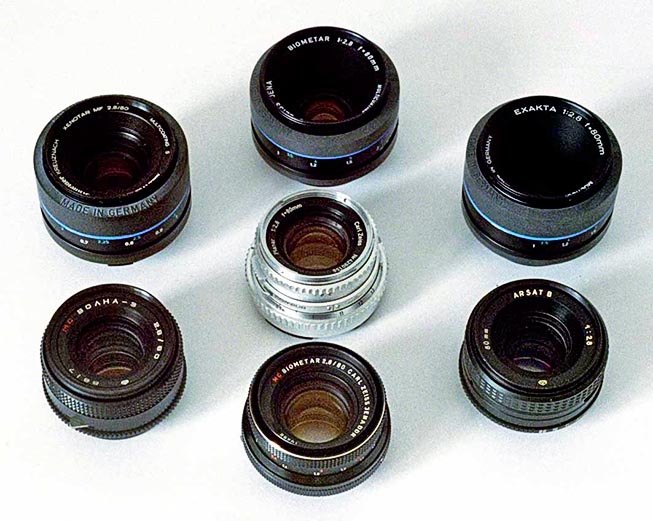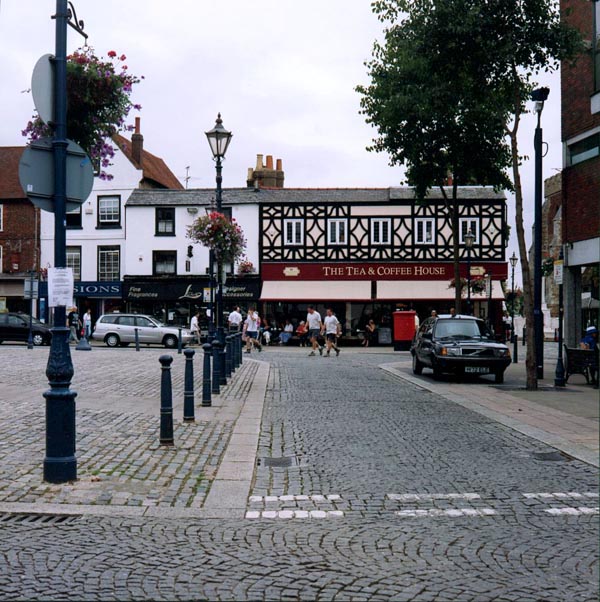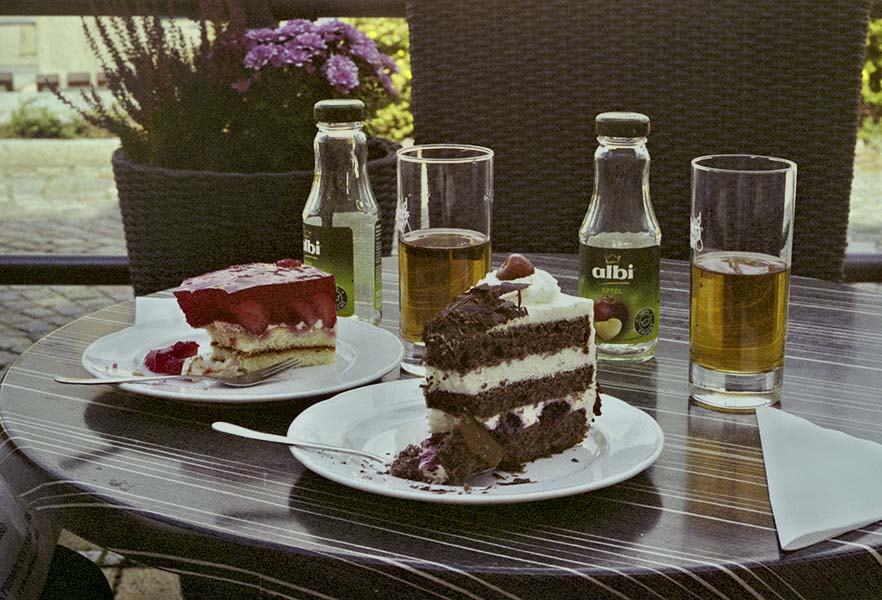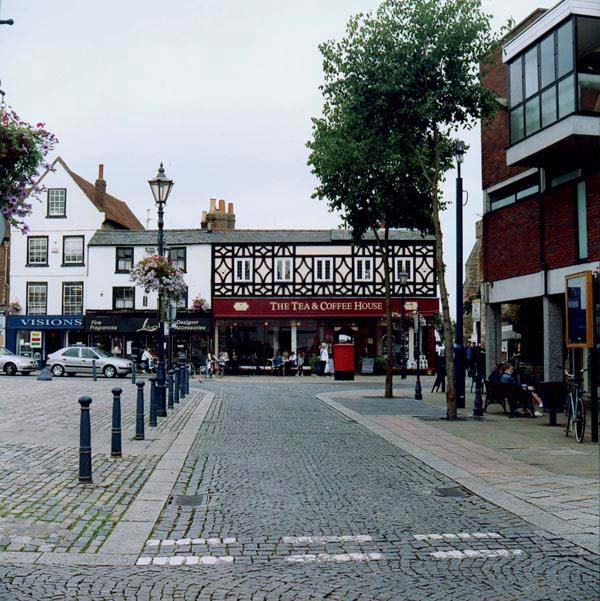Medium Format
Lenses with the Pentacon Six Mount
A comparative test
by TRA
The standard focal
length lenses
The following standard focal length lenses were included in the
test:
80mm f/2.8 Carl Zeiss Jena MC Biometar in standard Pentacon Six
finish (Rolf-Dieter Baier and some others call this the
“Mark II” version.)
80mm f/2.8 Carl Zeiss Jena MC Biometar in Exakta 66 finish
(Rolf-Dieter Baier and some others call this the “Mark III”
version.)
80mm f/2.8 Joseph Schneider MC Exakta
80mm f/2.8 Arsenal MC Volna 3
80mm f/2.8 Arsenal MC Arsat B
plus, for comparison purposes, the 80mm f/2.8 Carl Zeiss
Oberkochen Planar in Hasselblad mount.
These lenses are illustrated here, along with the top standard
lens produced for the Exakta 66, the Schneider Kreuznach Xenotar
MF

Back row from L to R: Joseph Schneider Xenotar MF, Carl Zeiss
Jena Biometar in Exakta 66 finish, Joseph Schneider Exakta
In the middle: Carl Zeiss Oberkochen Planar in Hasselblad mount
Front row: Arsenal MC Volna 3 on the left, Carl Zeiss Jena MC
Biometar in Pentacon Six finish, and Arsenal MC Arsat B on
the right.
Pictures were also taken with the 75-150mm f/4.5 Joseph Schneider
MC Variogon at 75mm
Some of these lenses were also tested with an appropriate 2×
converter. For ease of comparison, I am including the results of
these shots in the section on 150-160mm lenses.
For more information on the versions of the 80mm Biometar in
Pentacon Six design, see here.
For more information on the 80mm lenses available in Exakta 66
design, see here.
The results
In spite of the difference in focal length, I’ll start with the
standard lenses, and report on the zoom immediately afterwards.
80mm
The order in which I am describing these does not indicate any
hierarchy of quality.
I will start with the Volna 3 lens. At full
aperture the narrowness of the depth of field is of course very
obvious, so a large part of the picture looks extremely
soft. This is of course an optical fact, not a defect, so I
must concentrate on the plane of the image that was focussed
on. I would still describe this as disappointingly soft,
even close to the centre of the image (the cream-coloured sign to
the left of the title “The Tea & Coffee House”). The Arsat
B is equally soft at full aperture. To be fair, I
would have to mention that taking pictures at full aperture in
bright overcast conditions proved difficult: the exposure meter
indicated f/4 at 1/1000 sec, and as I didn’t have any ND or
polarising filters with me, I had to over-expose by one stop in
order to test f/2.8, so the film is not performing at its best,
either.
At f/2.8 the Exakta lens is no better than the Volna and
the Arsat. My impression is that off-centre the Exakta is
marginally less sharp than the Volna and the Arsat, but there is
very little to it. The Biometar, original version, is
sharper than any of the above at f/2.8, and the further from the
centre of the image one looks, the clearer is the
difference. So this looks like the best of the standard
lenses so far.
With the meter reading f/4 at 1/1000, and a maximum shutter speed
of “only” 1/500 on the Planar lens, the correct aperture
would have been f/5.6. As with some of the other shots, I
deliberately over-exposed by one stop, this time in order to test
the lens at f/4. To test it at f/2.8, I would have needed a
slower film or an ND filter. So the comparison is not quite
fair. However, I also took shots at f/4 with some of
the other lenses, so how do they all compare?
Firstly, the Planar at f/4 is – not
surprisingly – clearly MUCH sharper and
contrasty than any of the other lenses at f/2.8.
Stopping the Biometar, Pentacon Six multi-coated version
down to f/4, it looks every bit as sharp and contrasty as
the Planar at the same aperture, right into the edges, using a
7× loupe on an 8 × 8 print. A tiny variation in
print density has been introduced by the lab, but this is not
visible on the negative. To my surprise, the shot taken with
the Biometar in Exakta 66 finish at f/4 is not as sharp as
the Biometar in Pentacon Six finish. I wonder if
this is due to a slight focussing error on my part???
At f/5.6, the Pentacon Six Biometar is critically sharp
into the corners. (I didn’t test the Exakta 66 Biometar at
this aperture; I set out to compare the lenses at maximum aperture
and f/11 only.) The Exakta lens is equally sharp,
with perhaps slightly more contrast than the Biometar. The
result is definitely outstandingly good. The Volna 3B
at f/5.6 is as good as the Biometar. The amount of detail
resolved is incredible. I didn’t test the Arsat lens
at this aperture, but at other apertures it seems
indistinguishable from the Volna.
Now on to the next aperture that we set out to test: f/11.
Here of course the depth of field increases dramatically, bringing
the cobblestones in the foreground into sharp focus, which gives
the impression of a sharper image – though
what counts is the result in the plane that we actually focussed
on.
Not surprisingly, all the standard lenses produced superb
results at this aperture. The Planar is truly
excellent. But I will run out of superlatives.
Studying the definition at the very edge of the frame in
comparison with the modestly-priced Exakta, I can’t see
any difference – although some of the shop
signs look sharper with the Exakta.
These pictures were taken at 1/125 sec on a tripod, so I think
that camera movement and other variables have been reasonably
eliminated. (OK, the quality of the daylight or even the
purity of the air could change, but with the bright overcast
conditions any variation in brightness was not detected by the TTL
meter, and the traffic flow round the square was very light.)
The Biometar in Exakta 66 livery looks as sharp as the
Planar, until I take my 7× loupe to the two of them. Then it
becomes clear that the Biometar is fractionally sharper
than the Planar at the edge of the frame. The Biometar
in Pentacon Six style is indistinguishable from the Exakta
66 version, and I am convinced that the difference between them at
maximum aperture must be down to a slight focussing error – I should have used a focussing magnifier on
the prism, or the magnifying head.
The Volna 3 and the Arsat B are virtually
indistinguishable from each other at f/11. (The Arsat is possibly
almost immeasurably sharper than the Volna, looking at the red
“Peter Briggs” sign with the black lettering “Clarks” on a white
background, but I am not certain. Hazy shadows on the ground
reveal that there was slightly more brightness through the
clouds during the Arsat shot than during the Volna shot, and this
probably accounts for the tiny difference.) Both of these
lenses are the tiniest fraction behind the Exakta
at the very edge – though it takes the 7×
loupe and direct sunlight on the print to show this.
Seeing as at f/11 the Exakta seems sharper than the Planar, and
the Biometar seems sharper than the Planar, which if them is
better? As I examine my 8 × 8 inch prints now, the sun is
still shining on them, and with the 7× loupe again I can’t
distinguish any difference. Please believe me, I
did not set out to demonstrate this. Nor did I expect
it. I expected the Planar to come first, the Biometar to
come second, and the others to come in somewhere behind
them. From the few prints that I have scanned in with my
modest scanner, I can’t see these differences on the screen; one
hits pixellation before seeing this degree of detail. (This
is not surprising, considering what I discovered several years
later about the "Exakta" lens – see here, near the bottom of the
page.)

[C295-14: Biometar 80mm lens in Exakta 66 style at f/11, 1/125
sec]
The conclusion is that they all perform superbly, especially at
the apertures that we use most of the time: f/5.6 - f/11.
But I’m glad to have done the tests. It’s good to know what
we can trust our standard lenses to deliver the goods.
Incidentally, Rolf-Dieter Baier found some clear vignetting with
the Exakta lens at all apertures. I do not doubt the
validity of his tests, and can see the vignetting on his
website. But the vignetting was not visible at all
with my Exakta lens at any of the apertures tested.
Closest focussing distance with
the 80mm Biometar
For most of the pictures in these tests that were shot in Hitchin
market square, the lenses were focussed on or near
infinity, but how does the standard lens of the Pentacon Six, the
80mm Biometar, perform at its closest-focussing distance?
The following picture was an unplanned shot that was taken when we
stopped for a snack while we were in the small German town of
Zwönitz.

Zwönitz: Schwarzwälderkirschtorte, Erdbeertorte, Apfelsaft
Pentacon Six TL at 1/125 sec with 80mm Biometar at f/22 on
closest focus (1m), hand-held. Film was Fuji PRO400H.
This is very nearly the full width of the frame, just 1½mm
having been cropped off on the left-hand side.
Top and bottom cropped to suit the composition.
Lighting was far from ideal, with the table in the shade and
bright sunshine in the background.
Fuji’s 160 ISO film would have been a better choice, with
its finer grain, for a subject such as this one.
However, the overall result is perfectly satisfactory for a
spontaneous, unstaged shot, and the picture is a pleasant
reminder of delicious German cakes.
In answer to the question that we asked above, the
closest-focussing distance permits the user to take
excellent close-up shots of reasonably small subjects
– and the resolution of the lens is excellent.
[C548_7c.jpg]
|
The
Biometar and Bokeh
Further results with two different Pentacon Six 80mm Biometar
lenses are reported on here.
These show how out-of-focus highlights – known
as "bokeh" – are rendered by the lens when
it is used at wide apertures.
Light leak problems
with the 80mm Volna/Arsat lens
|
The 80mm Volna/Arsat lens from the
Arsenal factory in Kiev focusses much closer than the
Zeiss Biometar, but this is not really useable!
Why?
Tests by many users have shown that
when one focusses close up with this lens, as part of
the barrel moves forward, it allows light to
enter the camera via the slot that accommodates
the depth-of-field preview lever on the lens!!!
This is the most amazing design error by the
manufacturers, and as far as I have been able to
discover was never corrected in all the years that the
lens was in production.
(The problem was not revealed in my
test, reported on above, because I was focussing at or
near infinity, and at this setting light is blocked
from entering the camera body via this slot by other
components of the lens.)
It is possible to solve this problem by
taping over the depth-of-field preview lever
slot. (It is not necessary to remove the lever
first.) If you are using the lens on a Kiev 60,
you can still check the depth of field by operating
the lever on the camera body, but if you are using the
lens on a Pentacon Six, a Kiev 88 CM or an Exakta 66,
this is not an option. This also denies you the
possibility of doing metering at working aperture,
which I recommend when using the Pentacon Six prism or
one of the Kiev prisms.
However, one user now (June 2011)
reports: “in playing with a flashlight with the lens
at close focus, I noticed a significant amount of
light leaking through the focus distance cut-out in
the barrel, as well as the well-known DOF lever
problem. Therefore taping over the DOF lever slot
might not be enough to completely solve the problem.”
He concludes: “Better to just buy a
Biometar and eliminate the possible light leak
problem altogether, plus get better optics and image
quality as a bonus, and a more reliable aperture
mechanism.”
Thank you, Ken, for carrying out this
research and reporting it. Your recommendation
is also excellent!
|
Since completing these tests I have bought the
Joseph Schneider Kreuznach Xenotar MF 80mm f/2.8 lens, reputed
to be every bit as good as the Carl Zeiss Oberkochen
Planar. I have used it for regular photography, without
carrying out specific tests, and it certainly yields outstanding
results.
75mm
The 75-150mm Variogon has a maximum aperture of f/4.5. Here
I am just looking at it at its 75mm setting. Fully open,
this lens produced an image that was virtually indistinguishable
from the Exakta at f/5.6 (remember, that was extremely
sharp and contrasty). At f/11 the depth of field has
obviously increased considerably, bringing the foremost
cobblestones into focus. Apart from that, there is perhaps a
tiny increase in contrast, but that could just be down to the
marginal difference in the density of the two prints produced by
the lab.

[C303-11/12: Variogon at 75mm: f/11. 1/60)
If you can find a 75-150mm Variogon, and don’t mind its cost or
the weight of carrying it around with you, it is clearly a very
acceptable alternative to any of the standard lenses described
above – not to mention the other focal
lengths that it covers.
On to the telephoto lenses
Back to beginning of lens tests
Home
© TRA January 2002
Latest revision: August 2017



